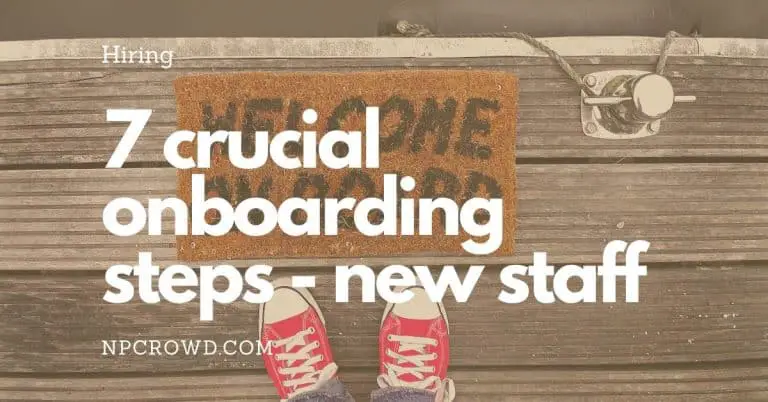Employee Benefits Made Easy for Small Nonprofits
Disclaimer: This post may contain affiliate links. These links, if used and purchases made, we may earn a small commission. These affiliate programs do not impact the recommendations we make or the resources we refer you to. Our focus is on providing you the best resources for your nonprofit journey.
Employee benefits are an important aspect of any organization, including small nonprofits. They not only help attract and retain talented employees but also contribute to their overall well-being. In this article, we will explore the key aspects of employee benefits for small nonprofits, including understanding the types of benefits, designing a benefits package, implementing benefits, and evaluating and adjusting them. Here are the key takeaways:Key Takeaways
- Employee benefits are crucial for small nonprofits to attract and retain talented employees.
- Understanding the different types of employee benefits is essential for designing a comprehensive benefits package.
- Identifying employee needs and preferences is the first step in designing an effective benefits package.
- Budgeting for employee benefits requires careful consideration of the organization’s financial resources.
- Effective communication and a streamlined enrollment process are crucial for successful implementation of employee benefits.
Understanding Employee Benefits

Why Employee Benefits Matter
Employee benefits play a crucial role in attracting and retaining top talent for small nonprofits. In today’s competitive job market, job seekers have greater bargaining power and are looking for more than just a paycheck. They want a comprehensive benefits package that meets their specific needs, including retirement help.
In fact, employer-based retirement savings and planning are highly valued by employees, ranking closely behind health insurance. By offering a strong benefits package, small nonprofits can enhance their employer brand, making it easier to attract and retain high-quality talent.
This not only reduces position vacancies but also saves time and money on recruiting and onboarding new candidates.
Additionally, providing employee benefits can increase productivity and job satisfaction, leading to a more efficient and engaged workforce. Investing in employee benefits is not only beneficial for employees but also for the overall success of the organization.
Types of Employee Benefits
When it comes to employee benefits, there are a variety of options available for small nonprofits. One important benefit to consider is the availability of PEOs (Professional Employer Organizations).
PEOs co-employ multiple businesses’ employees, allowing them to offer better employee benefits than individual nonprofits might be able to provide. PEOs typically offer medical, dental, vision, life, and long- and short-term disability insurance. They may also offer additional plans such as flexible spending accounts (FSAs), health savings accounts (HSAs), and health reimbursement arrangements (HRAs).
In addition to insurance plans, employees often receive retirement plans like 401(k) plans, as well as additional benefits like commuter and parking discounts, home and auto insurance discounts, and access to employee assistance programs.
Considerations for Small Nonprofits
When it comes to employee benefits, small nonprofits face unique challenges. Limited budgets and resources can make it difficult to offer a comprehensive benefits package. However, it’s important for small nonprofits to prioritize the well-being and satisfaction of their employees.
One important consideration is budgeting. Small nonprofits need to carefully allocate their resources to ensure they can provide valuable benefits without compromising their financial stability.
Another consideration is employee needs. Understanding what benefits are most important to employees can help small nonprofits design a package that meets their needs and enhances their overall experience.
Finally, small nonprofits should also consider staying competitive in the market. While they may not be able to offer the same level of benefits as larger organizations, they can still find creative ways to attract and retain top talent.
Designing an Employee Benefits Package

Identifying Employee Needs
When designing an employee benefits package, it’s crucial to first identify the specific needs of your employees. One way to do this is by conducting surveys or holding focus groups to gather feedback and insights. By understanding what benefits are most important to your employees, you can tailor your package to meet their needs and increase employee satisfaction.
Additionally, it’s important to consider the demographics and preferences of your workforce. For example, younger employees may value flexible work arrangements and professional development opportunities, while older employees may prioritize retirement savings and healthcare benefits.
By taking the time to identify employee needs, you can create a benefits package that not only meets their expectations but also helps attract and retain top talent.
Choosing the Right Benefits
When it comes to choosing the right benefits, it’s important to prioritize what matters most to you. While insurance and retirement plans are typically top priorities, don’t overlook the smaller perks that employers may be willing to accommodate. Consider factors like compensatory time for exempt employees and other benefits that align with your personal needs.
Negotiating benefits is often done after the base salary has been determined. Benefits can help bridge the gap between what was offered and what you were hoping for. If the employer is not transparent about the benefits they offer, don’t hesitate to ask for a detailed summary.
One important consideration when selecting benefits is the ease of use. Look for user-friendly software or platforms that empower employees to take ownership of their benefits. A clunky or complicated system can be a deterrent and hinder employees from fully utilizing their benefits.
Flexibility is another key aspect to consider. Ensure that the benefits package provides the flexibility you and your employees need. For example, if you’re a solo entrepreneur, a solo 401(k) plan may allow you to contribute more than a traditional 401(k).
Remember, not all benefits are valued equally. While perks like cereal bars and free parking are nice, employees often prioritize benefits like retirement savings and planning. A strong employer brand that offers valuable benefits can help attract and retain top talent.
Budgeting for Employee Benefits
When designing an employee benefits package, it’s important for small nonprofits to carefully consider their budget. While offering a comprehensive benefits package can be enticing, it’s crucial to find a balance between providing valuable benefits and staying within financial constraints.
One approach is to identify the specific needs and preferences of your employees. By understanding what benefits are most important to them, you can prioritize those that have the greatest impact.
Additionally, consider exploring cost-effective options such as partnering with professional employer organizations (PEOs) or leveraging government programs like the Qualified Small Employer Health Reimbursement Arrangement (QSEHRA).
These strategies can help stretch your budget while still providing meaningful benefits to your employees.
Implementing Employee Benefits

Communicating Benefits to Employees
Effective communication of employee benefits is crucial for ensuring that employees are aware of and understand the benefits available to them. If employees aren’t aware of their benefits, or they don’t fully understand them, there’s a chance it can lead to confusion and potential disputes about usage. To avoid this, it’s important to have a clear and concise communication strategy in place.
One effective way to communicate benefits is through a combination of written materials, such as employee handbooks or brochures, and in-person meetings or presentations. This allows employees to receive information in different formats and ask any questions they may have.
Additionally, consider implementing a table or a list to present the benefits in a structured and easily understandable manner. This can help employees quickly grasp the key features and advantages of each benefit.
Remember, effective communication of employee benefits not only ensures that employees are well-informed, but it also contributes to a positive employee experience and can help improve employee retention rates.
Enrollment and Onboarding Process
The enrollment and onboarding process is a crucial step in welcoming new employees to your organization. It sets the tone for their experience and can greatly impact their engagement and productivity. To ensure a smooth onboarding experience, consider implementing the following steps:
-
Provide a warm welcome: Make new employees feel valued and appreciated from day one. Introduce them to the team and provide a welcome packet that includes important information about the organization.
-
Streamline paperwork: Simplify the paperwork process by using digital onboarding tools. This allows new hires to complete necessary forms and set up their payroll information conveniently from a mobile device.
-
Communicate expectations: Clearly communicate the expectations and responsibilities of the new role. Provide an overview of the organization’s mission, values, and culture to help them align with the company’s goals.
-
Offer training and support: Provide comprehensive training to help new employees quickly get up to speed. Offer ongoing support and mentorship to ensure their success.
Remember, a positive onboarding experience can lead to higher employee satisfaction and retention.
Managing Employee Benefits
When it comes to managing employee benefits, it’s important to consider the specific demands and needs of your employees. While perks like cereal bars and free parking are nice, employees often value benefits like retirement savings and planning. In fact, according to a Society for Human Resource Management (SHRM) survey, retirement help sits at a close second to health insurance among the benefits employees value the most.
A strong employer brand can also play a crucial role in managing employee benefits. By building a positive employer brand, you can attract and retain high-quality talent, reducing position vacancies and saving time and money on recruiting and onboarding.
To effectively manage employee benefits, it’s essential to offer a range of options that cater to different needs. This can include retirement plans like 401(k) plans, as well as additional benefits like commuter and parking discounts, insurance discounts, and access to employee assistance programs.
Additionally, partnering with a Professional Employer Organization (PEO) can provide small businesses with an affordable way to manage their HR responsibilities, including payroll processing and taxes. PEOs can handle tasks such as processing payroll, administering direct deposits, and managing employee time off.
Overall, managing employee benefits requires a thoughtful approach that takes into account the specific needs of your employees and the resources available to your organization.
Evaluating and Adjusting Employee Benefits

Measuring the Impact of Benefits
Measuring the impact of employee benefits is crucial for small nonprofits. It allows organizations to assess the effectiveness of their benefits package and make informed decisions about adjustments or improvements.
One way to measure the impact is by analyzing employee satisfaction and engagement levels. Conducting surveys or holding focus groups can provide valuable insights into how employees perceive and value the benefits offered. Additionally, tracking metrics such as employee turnover rates and productivity levels can help determine the overall impact of the benefits on the organization’s success.
By regularly evaluating and measuring the impact of benefits, small nonprofits can ensure that their employee benefits package is meeting the needs of their workforce and contributing to the organization’s goals and objectives.
Making Adjustments as Needed
Making adjustments to employee benefits is an ongoing process that requires careful consideration. As a small nonprofit, it’s important to regularly evaluate the impact of your benefits package and make adjustments as needed to ensure it remains competitive in the market.
One important aspect to consider is the contrast between employee benefits available for small nonprofits and those offered by larger organizations. To attract and retain talent, small nonprofits should consider offering competitive salaries, emphasizing their mission and impact, and creating a positive work environment.
In addition, it’s crucial to listen to the needs and feedback of your employees. Conduct surveys or hold regular meetings to gather input on the benefits they value most and areas where improvements can be made.
When making adjustments, it’s essential to communicate the changes effectively to your employees. Provide clear explanations of the reasons behind the adjustments and how they will benefit the employees. This helps to maintain transparency and build trust.
Lastly, staying informed about industry trends and benchmarking against other similar organizations can provide valuable insights for making adjustments to your employee benefits package. By staying competitive in the market, you can attract and retain top talent and create a positive work culture.
Staying Competitive in the Market
In today’s competitive job market, it’s crucial for small nonprofits to offer attractive employee benefits to attract and retain top talent. With a narrower labor supply, businesses have to provide what candidates want to win top talent and build employee loyalty—and what job seekers want are excellent employee benefits. In fact, one in 10 employees would take a pay cut to gain a better benefits package.
To stay competitive, small nonprofits should consider offering unique fringe benefits and flexible work arrangements, like remote work (if possible), unlimited PTO, and flexible schedules. These benefits not only enhance work-life balance but also demonstrate a commitment to employee well-being.
Additionally, providing health and wellness stipends can further support employee well-being and create a positive work environment. Whether it’s gym memberships, wellness programs, or mental health resources, investing in employee wellness can lead to increased productivity and job satisfaction.
Remember, not all benefits are valued equally. While perks like cereal bars and free parking are nice, employees also have specific demands, such as retirement help. According to a Society for Human Resource Management (SHRM) survey, employer-based retirement savings and planning rank high among the benefits employees value the most. By offering retirement benefits, small nonprofits can show their commitment to long-term financial security for their employees.
In conclusion, staying competitive in the market requires small nonprofits to prioritize employee benefits. By offering unique and flexible benefits, investing in employee wellness, and providing retirement benefits, small nonprofits can attract and retain top talent, build employee loyalty, and create a positive work environment.
Frequently Asked Questions
What are employee benefits?
Employee benefits are additional perks or advantages that employers offer to their employees, in addition to their regular salary or wages. These benefits can include health insurance, retirement plans, paid time off, and other fringe benefits.
Why do employee benefits matter?
Employee benefits are important for attracting and retaining talented employees. They can also improve employee satisfaction, morale, and productivity. Additionally, offering competitive benefits can give small nonprofits a competitive edge in the job market.
What types of employee benefits are available?
There are various types of employee benefits, including health insurance, retirement plans, paid time off, flexible spending accounts, and more. The specific benefits offered may vary depending on the organization’s size, budget, and employee needs.
What considerations should small nonprofits keep in mind when designing employee benefits packages?
Small nonprofits should consider their budget constraints, the needs and preferences of their employees, and the competitive landscape when designing employee benefits packages. It’s important to strike a balance between offering attractive benefits and managing costs.
How can small nonprofits communicate employee benefits to their employees?
Small nonprofits can communicate employee benefits through various channels, such as employee handbooks, company-wide meetings, email newsletters, and online portals. It’s important to provide clear and accessible information to ensure employees understand and take advantage of the benefits.
What should small nonprofits consider when evaluating and adjusting employee benefits?
When evaluating and adjusting employee benefits, small nonprofits should consider factors such as employee feedback, cost-effectiveness, market trends, and legal requirements. Regularly reviewing and updating benefits can help ensure they remain competitive and meet the needs of employees.







